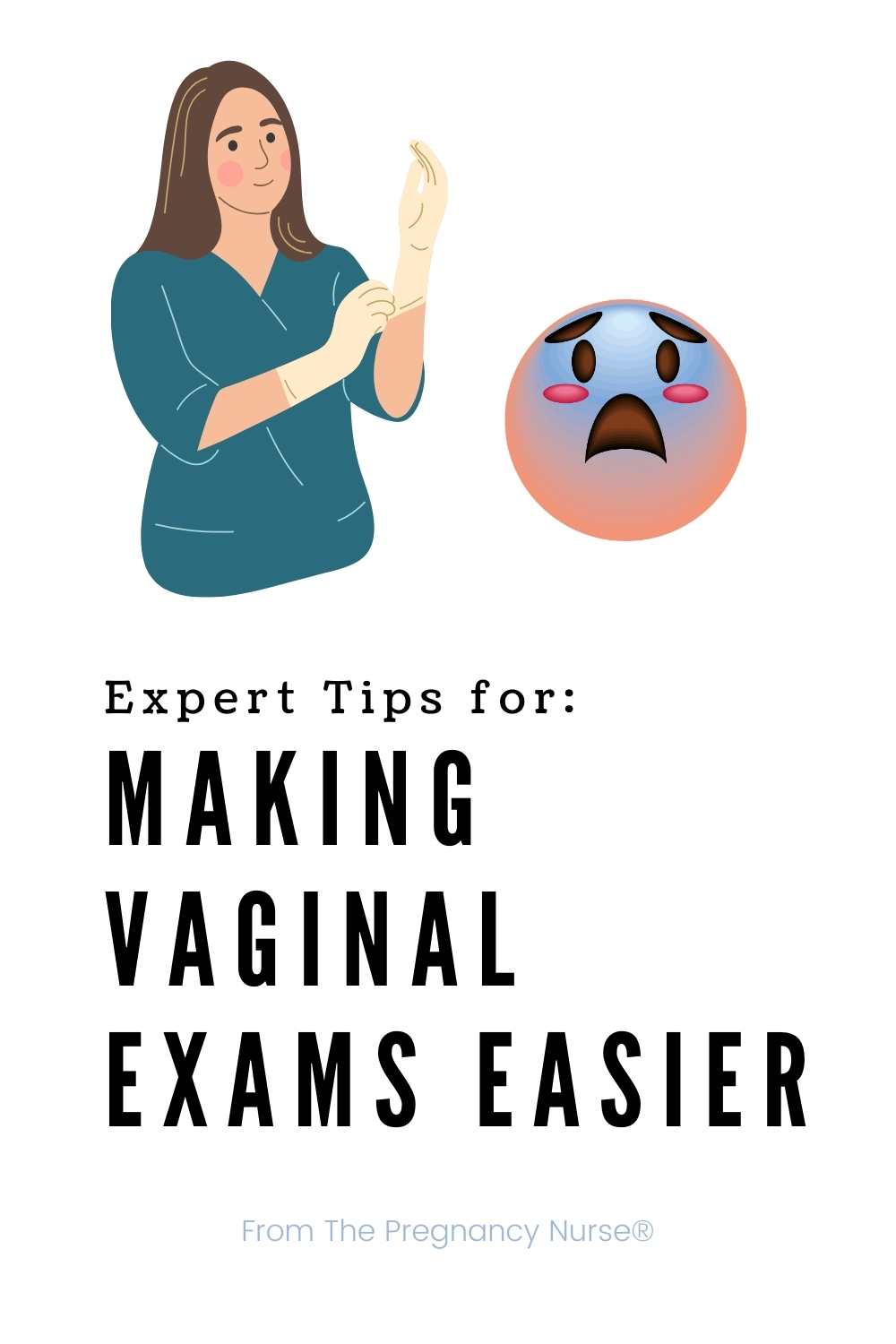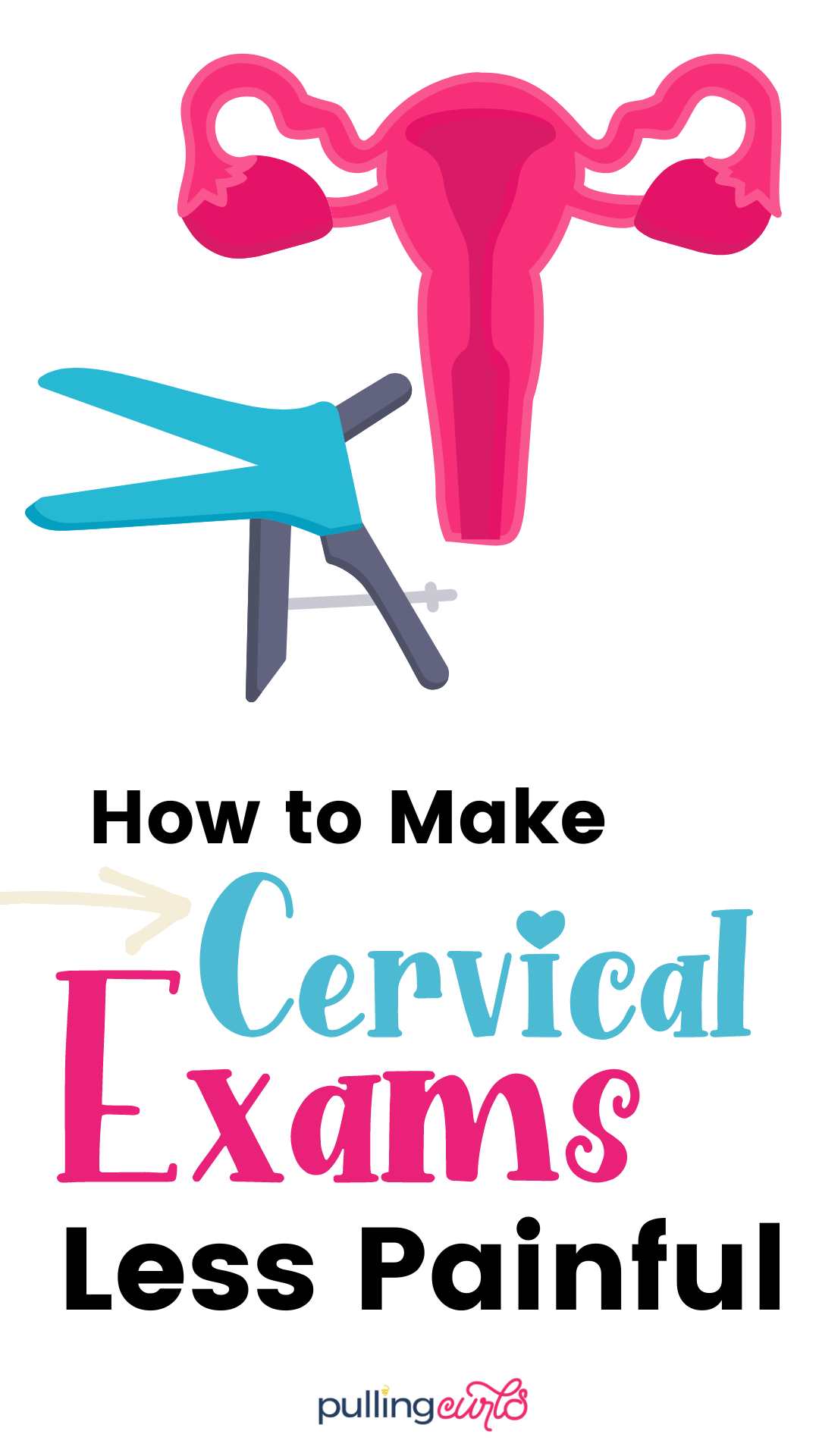Are you likely to have a cervix exam and wondering if it’s painful (or have already had one and are wondering how to make it better). Today we’re going to why they might be painful and what you can do to make cervical checks (also called vaginal exams) easier to handle.

How do I know so much about cervical checks? — many people know me as The Pregnancy Nurse 👩⚕️. I have been a nurse since 1997 and I have 20 years of OB nursing experience, I am also the curly head behind this website Pulling Curls and The Online Prenatal Class for Couples. 🩺 I’ve performed thousands of vaginal exams (and stopped many doctors as well). A lot of women have this issue, and I’m excited to share some great info with you today!
Vaginal checks may be part of your third trimester testing — so grab my free lesson about that right here:
Looking for advice on just how to make them less painful? Click here and jump to just that part (skip the part on why they hurt).
Do Cervical Checks Hurt?
Most people find them uncomfortable, but some people find them downright painful. The way our bodies are made down there (and every person is different, I can testify to that) really changes how we feel them.
Combine that with history of sexual assault or other issues and it can be really bad.
If you haven’t had an exam yet (I have a post here on when they start) you should just plan that you’ll do fine with it (and some of the coping skills in here might help as well). If you go in expecting it to be miserable it likely will be — so go in with a neutral mindset and I think you’ll be glad you did.
But why are they painful?
Can You Refuse a Cervical Exam?
Pro Tip: At ANY point in time you can refuse a vaginal exam (and we’re going to talk about that in this post). However, at some point, you will likely need one. You can certainly lessen the number of them and make sure they are only doing them when necessary.
FYI, you can really refuse pretty much anything at the hospital, but there are consequences.
I have a whole video about them:
I also have a post on my sister site about when cervical exams start.
When you are wondering if you NEED a cervix ask you & your provider these questions:
- Will this change my plan of care (for example if they think you’re in preterm labor and need to stop if it if you are, or if you’re planning on an induction they need to know how to start it)
- Am I curious to know the results? (I’ll never shame you for wanting to know what’s going on with your body)
If it won’t change your plan of care, and you don’t really care as to what the results are you may consider refusing.
We talk about pro tip questions like this a lot in here so you can get in the driver’s seat of your birth!
Why do providers do vaginal exams During Pregnancy?
There are several reasons why providers do internal checks
Pap Smear/STD Testing — It is standard of care to do an internal exam at your first appointment, as well as doing a pap test (checking for cervical cancer) and STD testing. This is done as a speculum exam. Your medical provider will also likely check for any issues with your uterus, ovaries and fallopian tubes with their hands (called a bimanual exam).
Most often they do this smear test to check for cervical irregularities at your first appointment.
As STD’s can affect your baby as you progress in your pregnancy, this is important to be done (and treated if they find one). However, those are just the Q-tips and you can ask you provider to just check for those. Many providers do these as a urine screen as well.
Assess for Preterm Labor — With my last baby, I had an internal exam from 28 weeks on. They said they were checking for any signs of preterm labor. I have heard that in Europe this is the standard of care as your provider will be able to tell if your cervix is shortening (aka, preterm labor).
There is a condition where your cervix just can’t keep closed called cervical insufficiency where they can place a cerclage that basically sews it shut until closer to your due date.
In retrospect, I have ZERO history of preterm labor (nor did my mom) and I wish I would have said no. But, even labor nurses get caught up in the white coat…
Assess for Labor Progress — As you get closer to your due date (often around your 36-38 week appointment) your health care provider might assess how open your cervix is (called cervical dilation). However, these are pretty fruitless. Just because your cervix is closed today, doesn’t mean you won’t go into labor tomorrow.
If you aren’t interested to know what it is, these are easy to refuse at the end of your pregnancy.
If you are in labor for a long time they will likely need to do one to check for labor progress and decide if a cesarean section is necessary. While they do it, they’re also checking baby’s head and baby’s position to possibly rotate you to aid in baby moving down the birth canal.
Beta Strep Testing — Beta Strep is a bacteria that they have found can be harmful if the baby is born through it in the birth canal. So, they test for it around 36 weeks. It is just a Q-tip that is inserted into the opening of your vagina and rectum. It should not be painful and is very quick (some doctors let patients do this themselves).
Stripping Membranes — (also called a membrane sweep) this is a procedure that can be done to bring on labor (although the studies are pretty low for it). This is considered the most painful exam as they use their finger to separate the cervix from the bag of waters and many people find it quite painful (myself included). Read more about stripping membranes << in that article.
Absolutely ALL of these exams should include an informed consent. Providers are bad about saying “now I’m going to check your cervix” but it 100% in your right (and it should be done) to ask why they’re doing and what they’ll do when they are in there.
Assess for Your Stage of Labor — When you present to your provider thinking you are in labor they will need to do an exam to see how far along you are.
For instance, we have women in a LOT of pain who are only one centimeter — and would be much better to go home rather than to stay in the hospital. So, as nurses, we do need to assess where you are at when you first present to the hospital.
Or women who are in preterm labor might need an exam to see what their cervix is doing — if it’s opening they might need bed rest.
Some providers do routine pelvic exams your last week of pregnancy, but you can 100% refuse them (but some pregnant women really like knowing what their cervix is — and both choices are OK).
Assess for Vaginal Bleeding — If you present bleeding, they may want to do an exam to learn more about what is causing it (“bloody show” is not unusual when you are in labor). I have a whole post on bleeding at 20 weeks.
I will say a lot of women find the unknown the most scary — and that can even add to your pain! The Online Prenatal Class for Couples is the easy way to get prepared (just 3 hours my friends)!
Some people find they are in pain even after a vaginal exam << and I explain why in that post.
How do medical professionals perform a vaginal exam?
They can either use their gloved hands (usually two fingers) or they can use a speculum (that’s the duckbill shaped implement they put inside).
The speculum is most often used when they need to visualize your cervix (most often needed for STD exams and a pap smear, although we sometimes use them in pregnancy as well for other reasons — including telling if your water is broken).
During pregnancy, we use a sterile glove in the hospital to be extra cautious about extra bacteria in the vaginal canal.
Most often the doctor uses a small amount of a lubricant (like KY jelly) to make it easier on your tissues. Some tests can’t have a lubricant, they can sometimes use water though.
** Some delivery centers do them every hour (or in some time of regular stages) to make sure a patient is progressing. This isn’t the recommended standard of care (and also not how I routinely practice). If you find that your nurse is doing frequent exams just because it’s policy — that is a time to opt-out of that policy (which is fine).
Pro Tip: A lot of people think you can do your own cervical exam in labor. Reaching your own cervix can be hard when you don’t have a baby, and it’s even harder if you don’t know what you’re looking for. I never tried it as I didn’t want to pull a muscle reaching back there.
BTW if you’re wondering about exams, be SURE you’re doing your kick counts — grab my cheat sheet here:
When not to have a Cervical Exam
There are times that your healthcare providers will NOT do a cervical exam. Most often it is due to a risk of infection once your water is broken. Once your water breaks the bottom line is that your uterus is open to any bacteria in your vagina which can be problematic.
If you bag of waters (or amniotic sac) is intact, there isn’t to much of a medical risk reason to not do an exam.
I actually have a whole post on cervical exams at 36 weeks that explains more about this.
What do they learn from a Pregnancy Internal Exam?
I have a whole post on what the numbers from a vaginal exam in labor mean.
Mostly they are learning the position of the baby (is it head down?), how far your cervix is opened or if it is shortened (called cervical effacement)
Also the position of the baby in relation to your pelvis (or how low the baby is).
I think of your cervix is a thick tight-necked sweater that must stretch over your head.
I will say that vaginal exams have gotten a bad rap on social media in the past. A well-performed exam by an expert provider can actually tell us a lot about your labor progress and any interventions you may need during labor. It’s not just a few numbers, it’s a total picture of your pelvic vault/birth canal for your provider.
We combine all this information into something call the Bishop score that is an easy well to tell each other how ripe your cervix is.
Informed Consent for Vaginal Exams
Your provider will have a reason to perform a vaginal exam, and you should feel free to ask as many questions as you’d like before they do it.
You should also feel comfortable that the exam is necessary (I find that helps me feel better about any discomfort I feel during the exam).
Doctors SHOULD Be asking permission before they do something with your body. The end. It’s up to us to set this expectation with them.
Procedural Tip: Most often your provider will have a “chaperone” who comes in the room when they perform a vaginal exam. Often, if your spouse/partner is in the room, they can forego this (that just protects the doctor if you were to say that something inappropriate happened during the exam).
Related: If you’re thinking about exams, be sure to get that hospital bag packed too:
Why are vaginal exams painful?
I see several places online that say a vaginal exam should not be painful.
And guys — after 20 years in labor rooms (as well as having my own 3 children), I have to say that for most women this just isn’t true (especially with your first baby).
They can be very uncomfortable. They are intrusive, some women find them humiliating (but they shouldn’t). AND, for a lot of women they bring up powerfully bad memories.
I would think this is fairly self-explanatory. Your vagina is a fairly small opening, and while you do use it during intercourse, that has a lot of different feelings and emotions involved vs a check-up.
A lot of people have pain during their first few times with sex, so it isn’t unusual or different for you to have issues with the vaginal exam as well.
You may feel that the doctor is being unfairly rough but most providers are doing it with the utmost respect, but they do have a “job” to do. Sometimes in order to do that “job” it is uncomfortable for you. We do know that prolonging it excessively only makes it worse most often.
Frankly, slowing down the process doesn’t really make it less painful — it just makes it last longer. That’s something to keep in mind.
However, you can 100% stop them at any time if you feel too much pain. Always keep that in mind! It’s just a fine line between being an adult to get the information that you need vs managing your pain with it.
Vaginal infections (including yeast or bacteria) can make exams painful as well. You can always ask your provider if they think you have one of those if you find them intolerable — that could be an issue!
Vaginal Exam Anatomy Lesson:
As a note, women have three “holes” in their bottom/perineum area. There is:
- Urethra: The hole you pee out of.
- Vagina: The hole the baby will come out of.
- Rectum: The hole poop comes out of.
It is not unusual for women to not understand/know those 3 holes before — so I just wanted to clear it up. 🙂 And yes, I talk about it in here in much more depth.
And I also have a whole post on avoiding pooping at delivery that talks a bit more about how these 3 holes interact at the end.
Something else to keep in mind is that first time moms tend to find the exams more painful than women who have had a baby. So, that’s good news for next time!
I love writing stuff like that down to remember next time. Which is why I made this pregnancy planner for you!
A quick soapbox moment: You don’t see men saying that their prostate exam wasn’t painful? No! They all dread and hate them, so when women say they hate exams we can support them by saying that they can be pretty miserable. No reason to chime in and say you love them!
Reminder: You CAN refuse
At ANY point in time, you can refuse a vaginal exam.
And, I am sad to say that many doctors don’t make this apparent. They just pull back the sheet and say they are going to check you (which is not informed consent).
I have a WHOLE (wonderful) podcast on how to say no in labor — but here are a few times it’s smart to say no to a vaginal exam:
- If you don’t see a reason for it — informed consent should make it clear why they are recommending it.
- You are waiting for your partner to come back to provide support.
- You would prefer they wait an hour.
- They are too painful and you simply don’t want to.
I also have a whole podcast just on refusing vaginal exams.
Keep in mind this can have consequences — and that there are times when you are in labor that you will likely need it done.
However, there are times that I see it done when it isn’t necessary, so I would encourage you to make informed choices with your team. Be sure to weigh the information you could get against the discomfort you might feel.
How to Make Vaginal Exams Less Painful
There are a few things you can do (and we’ll talk more about them below the list):
- Learn some breathing techniques to help you relax
- Push your bottom into the table rather than lifting up
- Wiggle your toes (read on to find out more about that one)
If you love little tips like wiggling your toes to make it easier, there are tons more tips for labor, birth and postpartum in here.
Relax to make vaginal exams less painful
Sure, it seems totally impossible, but the more you tense-up the more painful it will be during your vaginal exam. It just makes the “hole” smaller and that is harder on you.
Try to breathe and try to think about all the positive things about being pregnant including that cute baby (and yes, I go over that type of breathing in one of the bonus videos in this class).
Press down to make vaginal exams less painful
A lot of women lift their hips UP during a vaginal exam (one doctor I followed during nursing school called it the chandelier reflex). This makes it harder and more painful for you.
If you push your hips down, it helps you to relax.
Raise hips to make vaginal exams easier
Sometimes, if you have a tilted cervix (and most people do in early labor) we will ask you to put your hips on your fists (or we will put a bedpan under you) This different position raises your pelvis. BUT you are still able to relax as you are putting weight on your fists, vs tightening your thighs/butt to raise your hips up.
Wiggle your Toes
I had a lot of people comment they wiggle their toes during the exam (I think it makes it easier to relax your pelvic floor).
Find a midwife
I do not recommend lay midwives, I do recommend a CNM (Certified Nurse Midwife)– one that can deliver in the hospital and has a load of training.
However, midwives are often more gentle and explanatory with exams. If you find that your doctor is too rough, consider finding a midwife to work with.
Discuss feelings/issues with your provider to make vaginal exams easier
Women who had forms of sexual abuse often find vaginal exams very painful. Besides the physical pain, it can also bring up emotional pain that they maybe haven’t processed.
Discussing these issues with your provider can be helpful for both of you. Sometimes, by them being specific about what they are doing and why they need to do it, it might help your brain be more at ease with the process.
**Moms of previous stillborns or even miscarriages often have feelings “swept” up during vaginal exams and that can be really hard too.
In all of those cases, we can’t help you unless you let us know — so be sure to talk to us!
Get some support to make vaginal exams less painful
By bringing in your partner, your mom or a good friend, they can help distract you some during a painful time. Some women find a doula very helpful in this case.
I have a podcast episode on what a good doula can do for you:
Some women just feel very awkward with a physician in this experience. I can assure you that it is not awkward for the provider and that it is just their “job” to do that day. Sometimes support can help you in that awkward time.
As you get towards the end of pregnancy, talk with other friends to see if they found it painful. Maybe you’ll realize you’re not alone.
And remember to go in with an open might. Will no one loves exams, many people find them to be very tolerable, and something to get over with (including myself).
What to do if vaginal exams are too painful?
While you can limit the number of vaginal exams (you are free to refuse them at any time) it is important that they occur:
- In the beginning to do a pap smear and std testing.
- In labor, to see how you are progressing (but this is limited, no need to check every hour or so).
Other times, you can talk to your doctor to find out if the procedure is very necessary. Refuse it, if you feel you can live with the consequences of not doing it.
BUT….
EXCLUSIVE CODE: Use coupon code PULLINGCURLS to get $20 off The Bosch Mixer (also in stainless steel), Classic Grain Mill & Harvest Grain Mill, at Nutrimill.com
My Favorites:
🤑 The Artiste is a gem of a mixer at a great price.
💚 The Baker’s pack is what I use at my house, the paddles and the scraper make this my favorite mixer!
(💲💲💲 Use code PULLINGCURLS on either of those too to save $20)
You need to remember that your baby’s head is much larger than the speculum or your providers’ fingers.
You are going to need to work on your personal coping skills to get through it.
Even if you plan to get an epidural, you will need to learn how to cope with pain before an epidural.
You will also need a vaginal exam after delivery to make sure that things are healing well. Along with your recommended pap smear.
I can’t recommend taking a prenatal class any more. This one will give you the tools to:
- Decide if you NEED an exam
- How to cope with pain (with it’s natural pain mangement bonus video)
- Know what to expect so things just aren’t as scary!
The good news about vaginal exams
The further along you get in labor, and life — vaginal exams hurt less.
- As your baby progresses down the vaginal canal, it makes it easier for us to reach your cervix, and makes it less painful — your cervix moves forward as labor progresses (remember as they progress into the canal you dilate more too)
- Your baby will stretch those tissues and with subsequent babies it hurts less.
- You learn to cope with the pain better — and contraction pain gets more intense (so the exam feels less painful)
So, that’s good news. It is rare that a second-time mom finds them as painful as they did the first time they had a baby.
Ok, time to get that prenatal class in. There’s SO much about pregnancy and labor that I can help you with if you just take the time to take the class. The meat of it takes just 3 hours, so you can do it! Come join me!
Not sure we’re a good fit check out my free class — It’s your first step towards being your own birth boss.
















Safa khan says
Hii my name is safa i am 14 weeks preg and ia m due for pap smear my last pap was done in 2019 august and i was about to do it but kept delaying and later got preg and i am scared to do now because of early labor pain bleeding uncomfortable so can is their any other procedure to test for stds and also can i get my pap smear late in pregnancy because i wont be worried of going in labor like around 38 weeks ??
Hilary Erickson says
That’s definitely a question for your doctor. You can definitely do other STD testing, with just a Q-tip in the v. 🙂